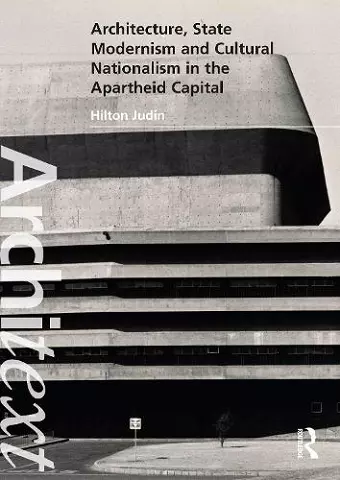Architecture, State Modernism and Cultural Nationalism in the Apartheid Capital
Format:Paperback
Publisher:Taylor & Francis Ltd
Published:8th Apr '21
Should be back in stock very soon
This paperback is available in another edition too:
- Hardback£145.00(9780367519438)

This book is the first comprehensive investigation of the architecture of the apartheid state in the period of rapid economic growth and political repression from 1957 to 1966 when buildings took on an ideological role that was never remote from the increasingly dominant administrative, legislative and policing mechanisms of the regime. It considers how this process reflected the usurpation of a regional modernism and looks to contribute to wider discourses on international postwar modernism in architecture.
Buildings in Pretoria that came to embody ambitions of the apartheid state for industrialisation and progress serve as case studies. These were widely acclaimed projects that embodied for apartheid officials the pursuit of modernisation but carried latent apprehensions of Afrikaners about their growing economic prospects and cultural estrangement in Africa. It is a less known and marginal story due to the dearth of material and documents buried in archives and untranslated documents. Many of the documents, drawings and photographs in the book are unpublished and include classified material and photographs from the National Nuclear Research Centre, negatives of 1960s from Pretoria News and documents and pamphlets from Afrikaner Broederbond archives.
State architecture became the most iconic public manifestation of an evolving expression of white cultural identity as a new generation of architects in Pretoria took up the challenge of finding form to their prospects and beliefs. It was an opportunistic faith in Afrikaners who urgently needed to entrench their vulnerable and contested position on the African continent. The shift from provincial town to apartheid capital was swift and relentless. Little was left to stand in the way of the ambitions and aim of the state as people were uprooted and forcibly relocated, structures torn down and block upon block of administration towers and slabs erected across Pretoria.
This book will be of great interest to students and scholars of architectural history as well as those with an interest in postcolonial studies, political science and social anthropology.
"In this new book, Hilton Judin tells the story of the unlikely marriage in postwar South Africa between the reactionary racism of the apartheid system and the technocratic, future-orientated utopianism of modernist architecture. In recent years, the distinctive forms of postwar modernism spawned by totalitarian communist regimes have been thoroughly investigated, but Judin’s book resoundingly fills in a glaring gap in knowledge at the other end of the ideological spectrum. It shows how modernist ideals and technologies, and grand, futuristic public building complexes – developed in alliance with an Afrikaner nationalism that also paradoxically concerned itself with researching ‘Bantu vernacular tradition’ - fuelled the mushrooming confidence and prosperity of the apartheid regime, and helped prolong its survival."
Miles Glendinning, Professor of Architectural Conservation and Director, Scottish Centre for Conservation Studies, University of Edinburgh
"In the increasingly precise cartography of the relationship between reactionary regimes and architecture, the policies of Apartheid South Africa had remained – appropriately, so to say, a white spot. Through a series of delicately carved case studies, Hilton Judin has brilliantly mapped the programs through which white supremacism has grounded its architectural expression – from the buildings for atomic research and science to the suburbs planned for the oppressed majority. Thanks to his rigorous investigation, this missing chapter of 20th century architecture is now open for further interpretation."
Jean-Louis Cohen, Sheldon H. Solow Professor in the History of Architecture, Institute of Fine Arts, New York University
"Hilton Judin’s book gives a critical account of Pretoria’s architecture in the 20th century focusing specifically on the period from the 1950s to the 1980s, covering the early to the late apartheid era in South Africa. In this volume Judin is able to explore the ‘psyche’ of the Nationalist government who commissioned the architecture which ultimately became the most effective physical symbol of the apartheid state, its policies, hopes and ideals in its most influential era… A must read for students and historians of Pretoria who seek to understand how the city's planning and physical structures were central to the promotion of the apartheid project in South Africa."
Ola Uduku, Liverpool School of Architecture, University of Liverpool
ISBN: 9780367519445
Dimensions: unknown
Weight: 420g
206 pages